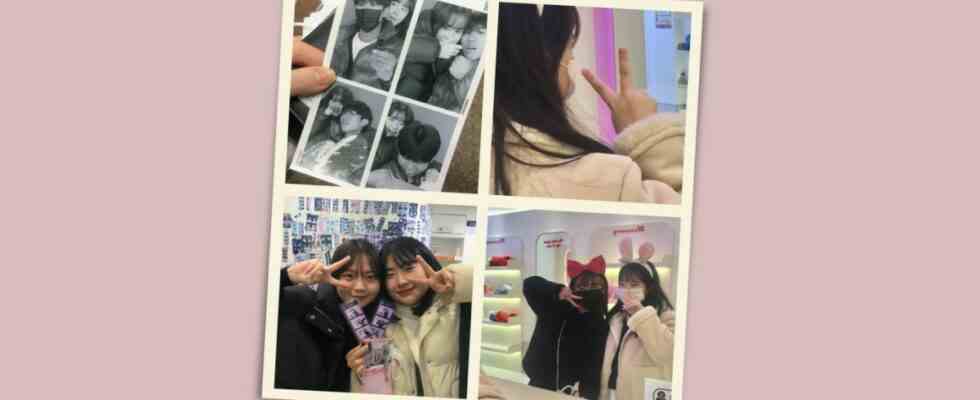Student Hwang Se-yoon is happy to explain why this evening shouldn’t end without a trip to a self-timer booth. However, not the same. With her boyfriend Park Jeong-huan, 23, the 21-year-old has just arrived at Photogray self-photo studio near Hyehwa subway station in Seoul. The two have each pressed a pair of animal ears into their hair. They want to take the photos first and maybe think about the question of the foreign reporter, which isn’t just about them, it’s about the popularity of instant photography in South Korea in general.
A few minutes later they are back. Hwang Se-yoon typed her answer into her smartphone and translated it into English using a translation app. “I think the purpose is to record and remember what you’ve done with friends or loved ones,” reads the display. “I think it’s a new tradition for young people.” She goes with her boyfriend to the self photo studio on almost every date. “About 80 percent.”
Selfies help with personal realization
The interest in one’s own image is probably nowhere as great as in South Korea. It is a side effect of the digital age, which is progressing particularly quickly in the tiger state. The smartphone here is, so to speak, a foodstuff from local production, manufactured and networked by the national conglomerate Samsung. Fast mobile internet is a matter of course, sending photos is an everyday activity. And taking selfies helps South Koreans in their personal fulfillment.
At least that’s how Seoul psychologist Whang Sang-min sees it. For Korea’s young people, it’s “a different way of expressing their self-image in the way they imagine it,” he wrote on the instant news service Kakaotalk when asked by SZ. “If they had a clear sense of themselves, they wouldn’t need it.” But South Korea’s competitive society, with its high expectations and prejudices, doesn’t exactly promote sustainable self-confidence. “As a millennial generation in Korea, their main aspiration in life is to be an ‘Insa’, meaning a person in a prevailing trend and part of the majority,” Whang explains, “by taking selfies, they can feel like they’re from to be recognized by others.”
The normal passport photo machine is no longer enough in South Korea. The newspaper reported three years ago Hankyoreh via a growing number of photo studios in which customers can take sophisticated profile pictures using a self-timer and a camera behind the mirror. The advantage over a professional photo shoot: without the photographer’s announcements, the images become more natural. Photogray and similar studios, which have opened up all over South Korea since 2020, are the cheaper option compared to these more expensive self-timer studios – the shop for the quick photo by the way.
They have a foyer with a dressing table and mirrors. You can take fun hats, colorful glasses or other accessories from the shelves. The cabins are equipped with the chicanes of the modern photo shop. For example, you can bring up certain frames that make it appear as if a K-Pop star or national soccer player is in the frame.
Song Seo-young and her boyfriend Han Seung-won take a black and white photo of themselves.
(Photo: Thomas Hahn)
The customer’s picture strips are stuck in various formats on the walls of the studios. Scenes from a merry country. Friends, couples, singles with or without fun hats, with or without corona masks. They smile. Make faces. Shape hearts or victory signs with your hands. “Koreans have a sense of humor,” says Han Seung-won, who snapped bare-headed black-and-white photos with his girlfriend Song Seo-young at Photogray.
The Studio Oldmoon in the theater district of Daehangno.
(Photo: Thomas Hahn)
Across the street in the Daehangno theater district, Studio Oldmoon is where 20-year-old friends Lee Su-min and Kim Min-ji from Chungchon want to immortalize their visit to Seoul. They both wear a bracelet that gives the impression that someone has rammed a screwdriver in their skulls. What is the point of taking pictures here? In Korean script they hurriedly write: 행복. “Haengbog. Happy.” Then they go into the cabin. You set the right program with routine movements. 7,000 won, 5.10 euros, for ten recordings, from which you can choose four. They end up on the smartphone via a QR code, along with a time-lapse video of the process of being photographed.
The blessings of digital computing have made self-photography an event that anyone can afford at any time. The Self-Studios act like little capsules of distraction. Because it’s not always fun to be young in South Korea. The conservative society here demands a lot from the youngsters. Many parents invest a lot of money in tutoring their children. The majority believes that for the best career opportunities you need a degree from one of Seoul’s prestigious universities. For such a course, you need good grades – and the highest possible scores on the Scholastic Assessment Test (SAT) in Korean, Korean history, English, math, science or society, which takes place every year in the third week of November for prospective students .
Jeon Ji-seon and Oh Hyeon-seo at a self photo studio in Itaewon entertainment district.
(Photo: Thomas Hahn)
A week ago, Oh Hyeon-seo, 18, and Jeon Ji-seon, 18, from Gwangju took this test. You have now traveled to Seoul to treat yourself to two relaxing days in the capital after the exhausting preparations. They had dinner and met a friend in the Itaewon entertainment district. At the end of the day they stop off at the self-studio on the main street. “We do this every time,” they say. They already have about 50 pictures. They appear relaxed and at peace with themselves. South Korea’s self-studios are places where real life takes a break.

